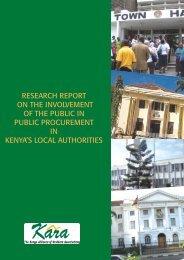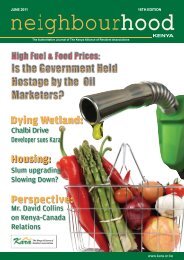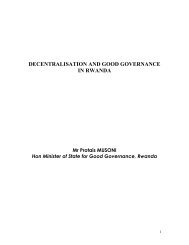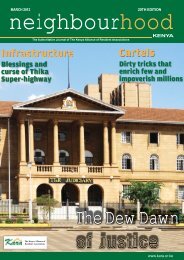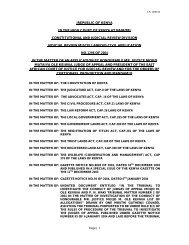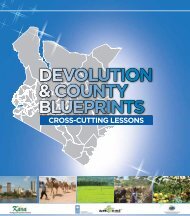KARA AUGUST 2011 ISSUE.indd
KARA AUGUST 2011 ISSUE.indd
KARA AUGUST 2011 ISSUE.indd
You also want an ePaper? Increase the reach of your titles
YUMPU automatically turns print PDFs into web optimized ePapers that Google loves.
FAMINE<br />
PHOTO: Courtesy Google.com<br />
The government spokesman Dr Alfred Mutua,<br />
a highly educated man with several degrees to<br />
boot, had the temerity to deny the obvious on<br />
national TV at the cost of taxpayers.<br />
Government offi cials, including the Minister<br />
for special programme Esther Murugi, insist that<br />
there is enough food. Indeed ours is a country<br />
of contradictions. It is said that while in some<br />
parts of Kenya food is rotting in others women,<br />
children and the aged are literally staring at<br />
death due to starvation.<br />
Why is it impossible for the Government to<br />
map out the areas with food and those without<br />
and, as Governments should, put in place<br />
mechanisms that enable redistribution of food?<br />
Again, the Government has been long on policy<br />
but short on implementation.<br />
Year in year out there are policy statements<br />
about how the country should migrate from rainfed<br />
agriculture to irrigation. The government<br />
went further and crafted a Ministry of Water and<br />
Irrigation. So where is the food and or who is<br />
not doing his job?<br />
The failure of government to plan and<br />
focus on long term projects has exacerbated<br />
the situation. A few years ago, Malawi was<br />
in the same situation as is Kenya today.<br />
However with proper planning and long term<br />
focus Malawi is an exporter of food.<br />
From the foregoing, there is need to put in<br />
place a programme for extension services to<br />
provide the knowledge and skills that farmers<br />
need to produce optimally. According to the<br />
Egerton University based Tegemeo Institute,<br />
Kenya has about 3 million small scale farmers<br />
who account for 75 per cent of the total maize<br />
crop.<br />
In addition, the national average maize<br />
yields per hectare are estimated at 20 bags<br />
of 90 kilogramme. These yields are about one<br />
twentieth of those attained internationally in<br />
countries such as Argentina.<br />
Besides, the land policy that allows<br />
subdivision of land to untenable sizes is<br />
also a contributory factor. There should be a<br />
minimum landholding in agricultural areas.<br />
Kenyan farmers are better advised to grow<br />
traditional crops such as cassava, potatoes<br />
and millet that are drought resistant and easier<br />
to store.<br />
Abundant worldwide evidence has shown<br />
that the incentives and ability of farmers to<br />
make investments in productivity-enhancing<br />
inputs and production methods depends on<br />
reducing the transaction costs and risks of<br />
exchange across inputs, credit, and output<br />
markets.<br />
Throughout the world, the major share of<br />
staple food costs to the consumer is typically<br />
accounted for by marketing costs. In most<br />
countries in eastern and southern Africa,<br />
maize marketing costs account for about<br />
40% to 60% of the total retail price of maize<br />
meal paid by consumers.The reduction of<br />
these costs represents a major opportunity<br />
to improve farm production incentives and<br />
simultaneously make food more affordable to<br />
low-income consumers.<br />
www.cofek.co.ke<br />
15.



